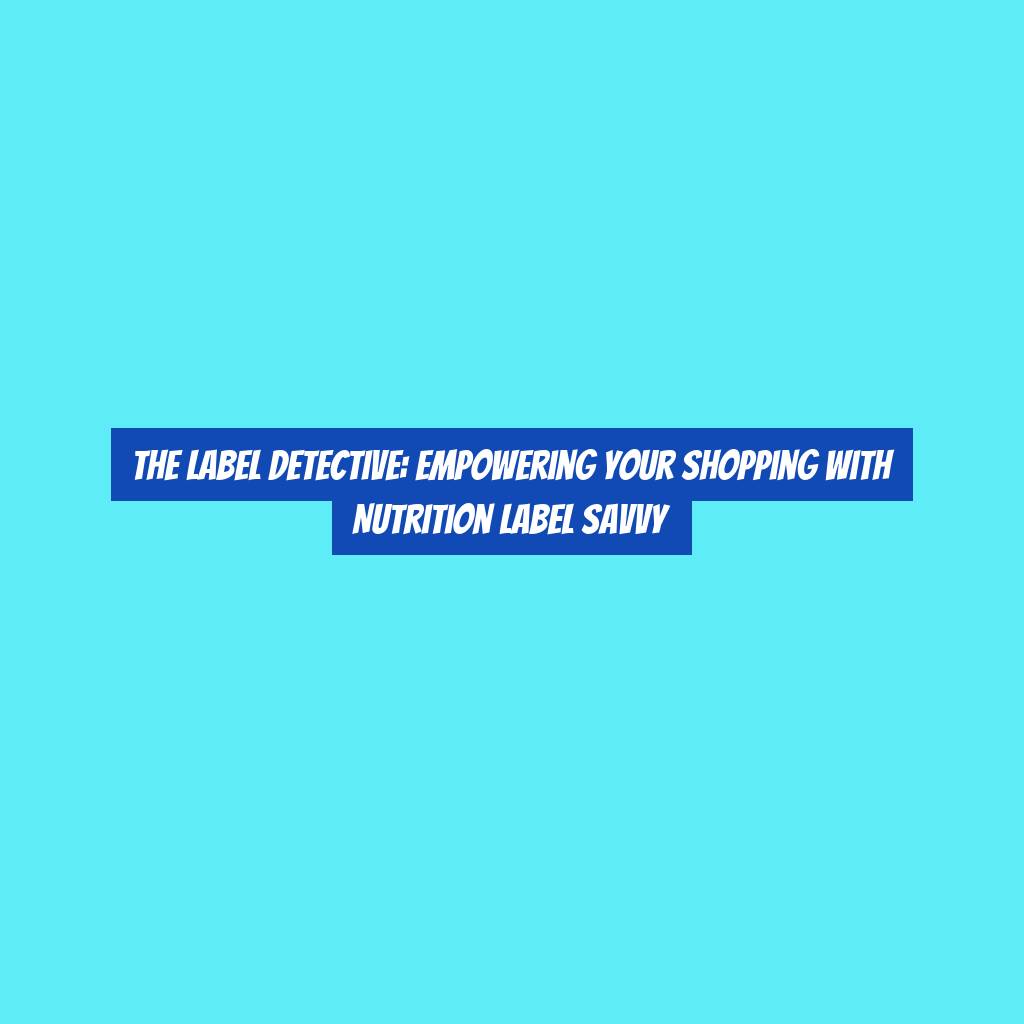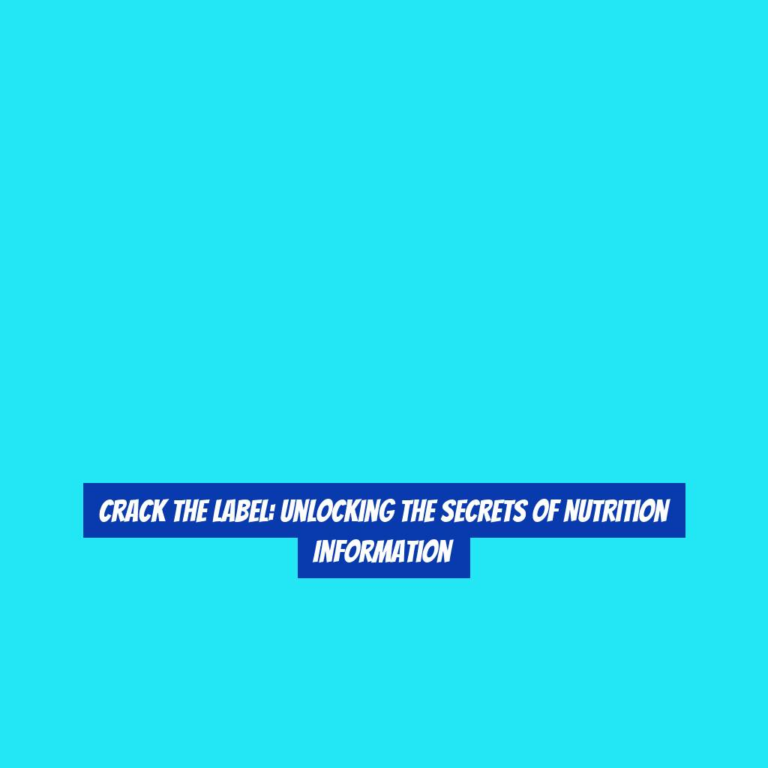The Label Detective: Empowering Your Shopping with Nutrition Label Savvy
Have you ever felt like thereG??s a secret language on the back of food packages that you just canG??t quite decipher? Understanding nutrition labels is like unlocking a hidden code that can empower you to make informed choices about the foods you consume.
But itG??s not just about knowing how to read the numbers G?? itG??s about being able to spot the sneaky ways that ingredients are listed and understanding the true impact of those nutrient content claims.
As you navigate the aisles of the grocery store, arming yourself with nutrition label savvy can be the key to making healthier choices for you and your family.
Understanding Nutrition Label Basics
Understanding nutrition label basics is essential for making informed choices about the food you consume. When you pick up a product at the grocery store, the nutrition label provides vital information about the serving size, calories, and nutrients.
ItG??s crucial to pay attention to the serving size listed on the label, as all the information provided is based on that specific portion. The calories section tells you how much energy youG??ll get from a serving of the food.
Keep an eye on the % Daily Value (%DV) for nutrients like fat, cholesterol, sodium, and certain vitamins. This helps you understand if the serving size contains a high or low amount of these nutrients.
The label also lists the ingredients in descending order by weight, so you can see what the food is made of.
Decoding Ingredient Lists
To decode ingredient lists, examine the list in descending order by weight to understand the composition of the food product. The ingredients are listed in order of predominance, with the heaviest components listed first. This means that the first few ingredients make up the majority of the product.
Keep an eye out for hidden sugars and unhealthy fats by looking for various names like high-fructose corn syrup, molasses, and partially hydrogenated oils. If these ingredients are listed near the top, the product may not be the healthiest choice.
Additionally, watch out for additives and preservatives such as artificial colors, flavors, and sweeteners, as theyG??re often indicated by complex chemical names. Familiarize yourself with common allergens like wheat, soy, and dairy, which may appear under different names.
Identifying Hidden Sugar and Sodium
Examine the ingredient list to identify hidden sugars and sodium content. This will help you make informed choices about the nutritional value of the food product.
When scanning the ingredient list, keep an eye out for terms like high fructose corn syrup, cane sugar, molasses, or any word ending in G??-oseG?? such as sucrose or dextrose. These are all forms of added sugars.
Additionally, be cautious of ingredients like monosodium glutamate (MSG), sodium nitrate, or sodium benzoate. These indicate the presence of sodium or hidden sources of added sodium.
ItG??s important to note that even seemingly healthy or savory foods like soups, sauces, and condiments can be loaded with hidden sugars and sodium.
By being vigilant about these ingredients, you can avoid consuming excessive amounts of these additives. Excessive consumption of sugars and sodium can contribute to health issues like high blood pressure, heart disease, and diabetes.
Taking the time to understand and identify hidden sugars and sodium will empower you to make more mindful and nutritious choices while shopping for food products.
Comparing Nutrient Content Claims
When comparing nutrient content claims, look for specific details on the packaging that provide information about the productG??s nutritional value. This information empowers you to make informed choices and ensures that youG??re selecting the best options for your health.
Here are a few key points to consider when comparing nutrient content claims:
-
Serving Size: Pay attention to the serving size listed on the packaging. This will help you accurately assess the nutrient content per serving and avoid underestimating your intake.
-
Calorie Comparison: Compare the calorie content of different products. Opt for lower calorie options to manage your weight and overall health.
-
Nutrient Density: Look for products that are nutrient-dense, meaning they provide a high amount of nutrients relative to their calorie content. This ensures that youG??re getting the most nutritional benefit from your food choices.
-
Added Sugars and Sodium: Check for claims related to reduced or low levels of added sugars and sodium. Choosing products with lower levels of these can help support a healthier diet and reduce the risk of certain health conditions.
Utilizing Serving Size Information
Aim to utilize the serving size information on nutrition labels to accurately gauge your nutrient intake and make informed dietary choices. The serving size listed on the nutrition label is crucial in understanding the nutritional content of the food you consume. It provides the basis for all the nutrient information on the label. By comparing the serving size listed on the label to the amount you actually consume, you can better manage your nutrient intake. For example, if the serving size is one cup and you eat two cups, youG??ll need to double all the nutrient values listed on the label to accurately reflect what you have consumed.
Additionally, the serving size information helps in controlling portion sizes. It allows you to understand the number of servings in a package and the amount of food typically consumed at one time. This can prevent overeating and assist in weight management. By paying attention to the serving size information, you can avoid consuming more calories, sugar, sodium, and fats than you intend to.
Ultimately, utilizing the serving size information empowers you to make more mindful and informed decisions about your diet.
Conclusion
Now that you have the skills to decode nutrition labels, you can make informed choices about the food you buy. By understanding the basics, decoding ingredient lists, identifying hidden sugar and sodium, comparing nutrient content claims, and utilizing serving size information, youG??re empowered to take control of your health and well-being.
So, next time you head to the grocery store, embrace your inner label detective and make the best choices for you and your family.





